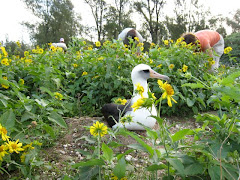 Unfortunately, not all seal encounters are this friendly. Hawaiian Monk Seals are one of the most endangered seals in the world, with approximately 1100-1200 individuals remaining, and a declining population. Their Hawaiian name, “’Ilio holoi ka uaua,” literally means, “the dog that runs in the rough (seas).” Most of the threats to these beautiful native animals are human, including entanglement in ghost nets, hooking by fish hooks, and habitat disturbance. When humans encounter these animals, they may not realize the importance of keeping their distance so that the seals can get their much needed rest on the beach.
Unfortunately, not all seal encounters are this friendly. Hawaiian Monk Seals are one of the most endangered seals in the world, with approximately 1100-1200 individuals remaining, and a declining population. Their Hawaiian name, “’Ilio holoi ka uaua,” literally means, “the dog that runs in the rough (seas).” Most of the threats to these beautiful native animals are human, including entanglement in ghost nets, hooking by fish hooks, and habitat disturbance. When humans encounter these animals, they may not realize the importance of keeping their distance so that the seals can get their much needed rest on the beach. During today’s seal module, PAA participants met with scientists Brenda Becker and Krista Graham, who introduced us to Hawaiian Monk Seal life history and some of the important research projects that they and other scientists are conducting. We then got to watch the team place a flipper tag on a newly weaned Monk Seal pup. These tags, along with photographs, allow scientists to identify individual seals and track them through adulthood, at least 25-30 years.
During today’s seal module, PAA participants met with scientists Brenda Becker and Krista Graham, who introduced us to Hawaiian Monk Seal life history and some of the important research projects that they and other scientists are conducting. We then got to watch the team place a flipper tag on a newly weaned Monk Seal pup. These tags, along with photographs, allow scientists to identify individual seals and track them through adulthood, at least 25-30 years.If you do happen to encounter these or other seals on your local beach, be sure to keep the following ‘rules’ in mind:
• Enjoy them from a distance, at least 150 feet
• Do not disturb them
• Keep dogs and other animals away from them
• Clean up after your pets—feces can carry disease
• Pick up your garbage and do not litter—most marine debris comes from land!
Photo credits: Meghan Marrero

















Aloha Kakou - I get so excited when I read this blog - Walterbea's poetry brought tears to my eyes. Just meeting you all and spending time with the PAA group has fired up my hui - I met with them last Saturday. Say hello to Brenda Becker for me - she helped my student Justine with her own monk seal study this last year. I'm off to DC tonight but will continue to check the PAA blog for inspiration. Hugs! Sandy
ReplyDelete